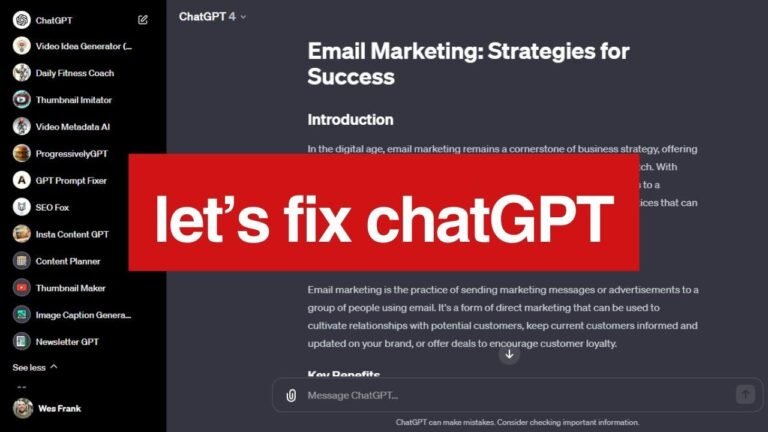“Everyone’s Curious: ChatGPT at Work – The Good & The Bad?”

ChatGPT at the office? Legal's freaking out! 🚫⚖️
But, find a loophole, nail a use case, show off the gains! 💪📈
Prove it's safe, score the next win.🎯
A spoonful of savvy, a dash of daring—let's stir up innovation soup! 🥄🍲
Key Takeaways: Pros and Cons of Utilizing ChatGPT at Work
| Pros | Cons |
|---|---|
| - Enhances efficiency with task automation | - Raises data privacy concerns |
| - May lead to significant time savings | - Legal risks for highly regulated industries |
| - Can be approved for specific use cases | - Could jeopardize company and customer security |
| - Can provide quick business value | - Unclear company policies on AI usage |
| - Potential to innovate within departments | - Risk of covert usage by employees |
Remember, each key takeaway highlights the primary aspects that affect the integration of ChatGPT in enterprises.
Pros of ChatGPT Integration
Utilizing ChatGPT within the professional environment offers several benefits. Firstly, it could dramatically enhance productivity and efficiency by automating mundane tasks. This could lead to measurable gains in performance metrics, such as a 20-30% increase in operative efficiency. Proponents also argue that with established guardrails, it's possible to maximize the technology's advantages without compromising organizational security.
Clear Use Cases
When implementing ChatGPT, identifying specific applications that don't conflict with company policies is crucial. Establishing transparent use cases for ChatGPT allows organizations to evaluate its benefits conclusively, thereby avoiding potential misuse.
Secure Approval Step by Step
Get one use case approved, demonstrate its effectiveness, and then move on to the next. This incremental approach can ensure compliance and gradually earn trust within the organization.
Business Value Communication
Clearly articulating the potential business value and efficiency gains is essential when seeking approval. Focus discussions on organizational goals rather than the desire to use the technology.
Leading by Example
Engagement from top management, such as the CEO, could be pivotal in obtaining necessary clearance. A compelling case for the potential savings in hours and resources might sway top-level executives to endorse the technology.
Legal Considerations
It's crucial for marketing professionals and other proponents of ChatGPT to understand the legal implications of deploying this technology, particularly in regulated industries. This understanding helps in negotiating its use within the company's legal framework.
Concerns and Restrictions
Despite the pros, there are significant concerns regarding the use of ChatGPT in the workplace.
Data Privacy
The potential for data leaks or unauthorized access to sensitive information is among the primary concerns, leading to some companies prohibiting its use.
Regulatory Hurdles
Organizations in strict regulatory environments may limit its use due to legal considerations and to protect customers and business operations.
Addressing the Legal Bottlenecks
Building a cooperative relationship with legal departments and IT can help in crafting a pathway for safe testing of ChatGPT in the workplace.
Risk Management
By proving reliability and lack of incurred risk with each approved use case, companies can slowly broaden the technology's adoption within the firm.
Policy and Transparency
Transparency in AI usage policies, and providing clear guidelines can help mitigate the risks and set the stage for future opportunities.
Fluid Over Fixed
A dynamic and well-communicated policy is better than a non-existent or unclear one. This helps employees understand their boundaries and how to work within them.
🌟 ChatGPT’s Journey in Corporate Environments
While some companies were quick to say no to ChatGPT upon its arrival, others have gradually opened up, albeit with strict guidelines. This evolution reflects the technology's potential and the corporate world's cautious but growing interest in it.
The Unofficial Adoption
Despite official stances, many employees in highly regulated firms use generative AI tools without informing employers—a trend that indicates latent demand but also highlights a need for clear policies.
Taking the First Steps Safely
For those eager to integrate ChatGPT, it's recommended to start small and tactfully increase its usage, ensuring compliance and demonstrating tangible value step by step.
Emphasis on Efficiency
Ultimately, focusing on the efficiency gains and time saved can be a compelling argument when proposing ChatGPT's use to upper management and legal departments.
Conclusion: Navigating AI Adoption in a Regulated Realm
The integration of ChatGPT within the workplace needs to be carefully balanced with a well-structured approach. Understanding organizational goals, legal boundaries, and the potential to improve efficiency can help navigate the complex landscape of AI adoption. Communicating openly with all stakeholders, creating incremental approval processes, and establishing transparent policies are key to successfully harnessing ChatGPT's capabilities for business growth.





![[NEW WAY] How to Create a Talking Avatar with Canva and Artificial Intelligence [Free]](https://gptstester.com/wp-content/uploads/2024/01/WP-20240120145204-119166-768x432.jpg)
